Knit and crochet sweaters were an everyday garment for active Edwardian girls and women. Edwardian sweaters are still in style today. So knit, crochet or sew your own Edwardian sweater this winter following one of the 25 free antique Edwardian sweater patterns. Winter is coming! 😉
‘There is a proper and improper time to wear a sweater […] For country wear and sports it is frequently worn as the only outside garment […] For wear in cities and towns a contrary etiquette prevails.
No woman should think of appropriating the sweater as a coat for any but the above named purposes. She should not wear it when she goes a-shopping or a-calling and for similar service. This is in inexcusably bad taste and immediately proclaims the social status of the wearer. Children in the country and cities wear them to school and at play, but this privilege must not be extended to their elders.’ (Los Angeles Herald, January 1906)
The Edwardian Sweater Girl
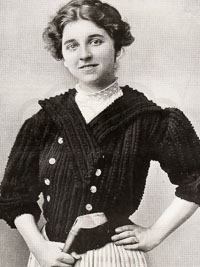
‘You will see the sweater girl this year. She is afield, very natty in her short skirt of navy blue and her gray hat and pale blue sweater. She rolls her sleeves to the elbow; to show a pair of plump arms, and she lets the lower edge roll up to give herself a mannish appearance. The sweater girl is out reducing her weight, for she must get lean by fall, and she knows that she must do as the boys do when in training.
Perhaps the sweater girls wears the garment because it is becoming. It opens nowhere and is easy to put on, being pullable over the head, and requiring only a smoothing down. For the girl who dresses in this way there are not many garments required. Next the skin there is a silk combination; then come her shoes and stockings and an outing corset. Out of regard for feminine fancy she can wear a trifle in lingerie, if she so desires; and then comes her outing skirt and her precious sweater, not forgetting that wonderful Panama hat, which is her special pride, with its dark binding and its flaunting quill’ and emerald chiffon veil. (San Francisco Call, July 1902)
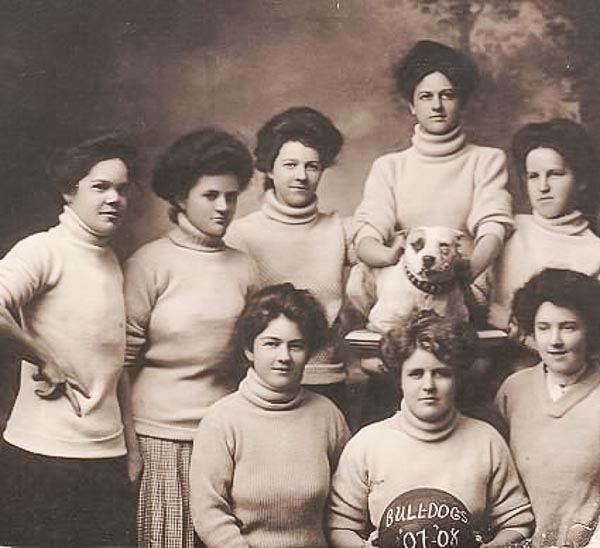
Edwardian Sweaters & Sweater Jackets
‘Now is the season of the sweater, not only in the wearing, but in the making. Sweaters from being the property of the sporting young son of the household have come to be a part of the necessary wardrobe of every member, from the tiny two-year-old toddler to the middle-aged matron.’ (San Francisco Call, September 1906)
Feminine Edwardian Sweaters
‘The new sweaters […] have lost their similarity to a man’s sweater and now come in many varying styles. […] for this year she is to be a delightfully feminine creature, whether in outing costume or piazza frock.’ (Los Angeles Herald, May 1903)
‘The sweater has taken a new lease of life for 1906. No longer the athletic girl and college man monopolize this practical garment and its sister companion, the golf vest. These knitted and crocheted articles of enduring wear are numbered among almost every woman’s wardrobe, the style and color being left to individual taste. […]
Tight-Fitting Sweaters
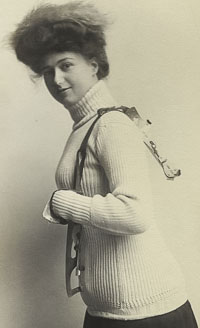
Since the college girl adopted her big brother’s sweater which she pulled on and off her head in an undignified fashion, it has been so feminized that one hardly remembers its very masculine parent. In the first place, it has assumed a becoming shape, clinging snugly to the lines of the figure, almost as affectionately as did the old time “Jersey,” with its formidable row of buttons down the front. English women are especially partial to tight-fitting styles, and one should remember that these are warmer than those inclined to blouse over the waist, which let in the cold.
The Perfect Fit Of The Sweater
Sweaters are made sufficiently broad across the shoulders to permit ample freedom and are also conveniently broad across the chest. The armholes should never bind. The back fits to the figure with hardly a wrinkle and neatly fits to the waist, being held in place by a narrow band that is usually of a finer stitch than the body of the sweater, but matching the collar and cuffs. […]
Blouse sweaters are seen in compliance to the outline of the straight front, the puff over the waist line being but slight. […] The newest pattern in blouse sweaters […] is crocheted in the fan or shell stitch, and has revers which may be worn closed and a high storm collar.’ (Los Angeles Herald, January 1906)
Buttoned Sweater Jackets
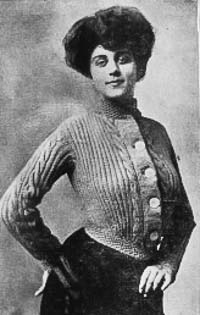
‘Sweaters are considered indispensible nowadays in the autumn outfit. The new sweater is buttoned at the side’ (Los Angeles Herald, November 1909). ‘The single-breasted sweater is not only popular with the small boy, but with grownups, and especially with women. […] Another sweater is high in the neck and opens on the side of the front, giving a double-breasted effect.’ (San Francisco Call, September 1906)
‘Shetland wool sweaters made to button in front and of much the same length and shape as the one time reefer jacket are now preferred to any other style of knitted wooled jacket.
They are delightfully soft, these sweaters of Shetland wool, and so light and fine that they can be slipped on under the most tight fitting coats, while they are at the same time sufficiently warm to be worn well into the autumn without the necessity of another wrap.’ (Los Angeles Herald, September 1909)
‘Many of the sweaters are so made that they may be worn open at the neck in front. This detail is especially noticeable on double-breasted garments, which are so fashionable this winter.’ (Los Angeles Herald, January 1906)
Sweater Collars
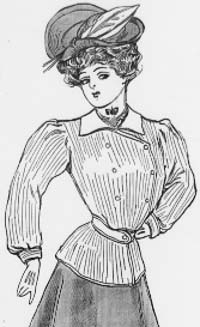
‘The new sweater […] has a rolling collar, which is comfortable for snappy weather.’ (Los Angeles Herald, November 1909) ‘The newest sweaters can be worn without a collar if desired, as they are cut a trifle low in the neck and look well worn without.’ (Los Angeles Herald, May 1903) ‘Sailor collars are not always satisfactory in sweaters, especially for women.’ (San Francisco Call, September 1906)
‘The best model is made exactly like a man’s coat, with revers and turnover collar. The revers may then be turned over and the collar buttoned high around the neck.’ (Los Angeles Herald, January 1908)
‘One of the most practical details noticeable among the new sweaters is the high collar attachment to be worn with sweaters having a surplice neck. This adjustable piece is in the form of a chemisette or chest protector, with high roll collar, and is frequently worn independent of the sweater with tailored street suits. For skating and other outdoor sports this little accessory is especially desirable, and does away with the fur neckpiece, which, unless quite small, like a cravat, is sure to be in the way.’ (Los Angeles Herald, January 1906)
The Sleeves
‘Sleeves are made over several attractive designs. Some are almost as small as coat sleeves, but the latest models show much more fullness, being patterned after the modified leg o’ mutton type. The cuffs are both wide and narrow and turn back from two to four inches.’ (Los Angeles Herald, January 1906)
‘In all the sleeves are quite full. Sometimes they are in one piece with the body, but more often they are separate and joined with a chain stitch.’ (Los Angeles Herald, January 1908)
Edwardian Norfolk Sweaters
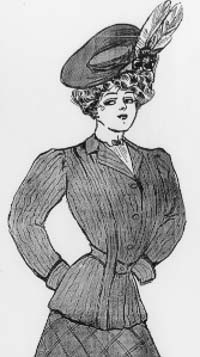
‘Among the best selling designs are those patterned after the Scottish Norfolk jackets. Even in jackets which stop at the waist the box plaits are evident.’ (Los Angeles Herald, January 1906) ‘Among the more recent and very taking varieties of the ever useful sweater is the Norfolk […] Made in fine yarn, it shapes itself beautifully to the figure, is soft and elastic, smart in appearance and very comfortable.’ (Sotoyome Scimitar, May 1904)
Long Coat Sweaters
There are ‘new coat models which the younger set wore during the early part of the winter with separate skirts and shirtwaists before putting on their heavy winter ulsters.’ (Los Angeles Herald, January 1908)
‘The coat shape has well-nigh ousted all others from the field. This is as might be expected, for since the sweater is relied upon to take the place of a coat during country residence, the coat shape naturally suggests itself to the mind of the maker.’ (Marysville Daily Appeal, 1906)
‘For fall and winter sweaters are indispensable whether one intends to sit on the veranda at home or motor. The most striking sweater development of the season is the increase in length. Many of the short sweaters are still worn, but the most popular is the coat sweater reaching to the knees or below, and in all lengths between this and the hip length. The long sweater is the outgrowth of the long coat fad.’ (Sacramento Union, September 1909) ‘Small tail-pieces from two and a half to six and eight inches are seen upon many of this season’s best styles. This detail is copied from the style in short hip length coats.’ (Los Angeles Herald, January 1906)
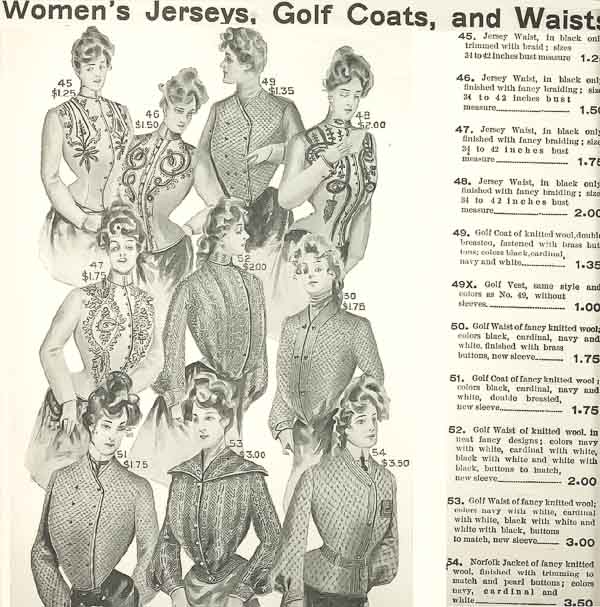
Edwardian Sweater Colors
‘Color for sweaters must be discreetly chosen when worn as a whole or only portion of the garment.
Neutral Colors – White, Gray & Dark Blue
Several years ago college girls wore vivid colors, but a decided improvement has been made. White or cream white, with the initials of the alma mater in colors, has come to be recognized as better taste, which it undoubtedly is.
Dark blue and grey should always be chosen in preference to hunter’s green and scarlet. There are some women, however, who should choose neutral colors, but who set aside these and go in for those which might even spoil the beauty of an acknowledged belle. Grey in several shades is chosen in preference to white because it is known to give much service before cleaning.
Colorful Collars, Cuffs & Bands As Trimming
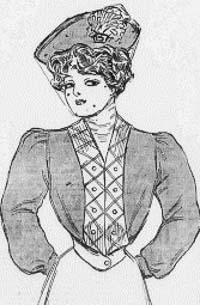
A pleasing touch of color is given to neutral colors by a dash of contrasting shade in the collar, cuffs and girdle. White or cream is added to grey, grey to dark blue and even dark green. Scarlet is especially becoming to children, but more white sweaters are seen trimmed with scarlet than employed for entire garments – that is, among the better dressed youngsters.’ (Los Angeles Herald, January 1906)
‘Again the collar and cuffs are in a different color, such as brilliant red on white, red on gray, or black or blue on white. […] ‘A pretty golfing costume […] was a short plaited skirt of red motora silk […] with a white sweater that had red collar and cuffs and fastened double-breasted, with white pearl buttons. The hat was a small white felt, mushroom shape’ (Los Angeles Herald, January 1908).
‘Colored bands, pocket flaps and collars are used for trimming white and gray sweaters. One of the most swagger women’s sweaters shown at an exclusive shop was long, single breasted and made entirely of gray, with the exception of a shallow turndown collar, pocket flaps and wristbands of scarlet. An all white woman’s sweater was unusually long and loose fitting. […] Another sweater […] is in white, with a band of blue down the side and a belt of the same.’ (San Francisco Call, September 1906)
‘A particularly good looking one is seen on this page in a dark red, a color more pleasing than brilliant red. A child’s garment in white is attractively enlivened with scarlet band trimming. A model is also depicted showing the tartan plaid revers.’ (Los Angeles Herald, January 1906)
Dotted & Striped Sweaters In Contrasting Colors
‘The new sweaters […] are dotted, they are striped in a contrasting color, and the very newest are trimmed with big pearl buttons and made with an adjustable collar. […] The white sweaters will be the most fashionable and those flecked with green will be next in favor. The white sweater is much more universally becoming than those worn of yore, and, mayhap, that is the reason that the summer girl has decided in its favor’ (Los Angeles Herald, May 1903). ‘White and gray are about equally popular […] while in the ordinary hand or machine knitted jackets there are to be had models in practically any shade desired.’ (Los Angeles Herald, September 1909)
‘The shops are showing skating sets of sweater and toboggan in white, gray and brown worsted, plain and fancy stitches. Some are in two-tone coloring, such as white or light gray, with stripes of brown, blue or red, and the effect is very pretty, especially if the short outing skirt happens to match the color of the stripes.’ (Los Angeles Herald, January 1908)
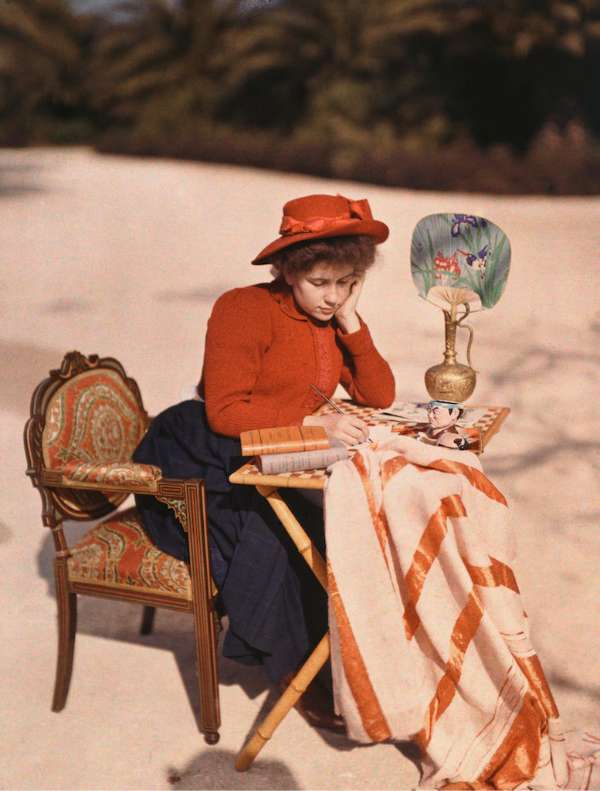
Edwardian Golf Vests
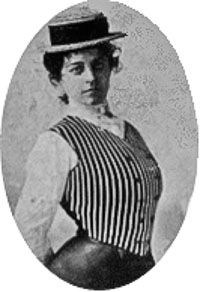
‘Have you fallen in love with the new golf vests? If you have not, then one or the other of two things is certain – either that you do not play golf to any extent or that you are not co-ed and never trip gayly over the campus. For they’re all the rage just at present, and a fit and fine rage they are, too.
The girls who got up early enough to defy the winds that sweep over the Presidio links found coats awfully in the way. The sleeves bound and the action of the arm was not as free as it ought to be to give a smashing blow. The next thing they tried was a sweater. Just an ordinary sweater, but it is such a homely affair that only the bravest really felt at all at home in them. And then again, there was the question of sleeves.
The manufacturers felt that something new was needed […] It was a soft jersey, with raised ribs. The back fitted snugly and was made to exactly fit the space between the top of the belt and edge of the collar. By way of contrast the front was striped with white. There was the red and the white stripe alternating. The vest, by the way, was red, as most of them are.
Collarless V-Neck Vests
The collarless effect is still fashionable, and this particular one was like a man’s vest – V-shaped and double-breasted. The buttons were put on wide at the bottom and narrowed toward the waist. The last two were on the tiny dip that all the “kangaroo” girls insist on having. […]
Buttoned Vests
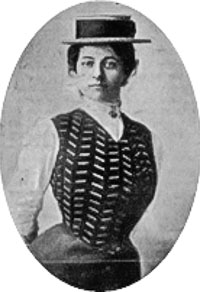
You pull a sweater on over the head and the hair suffers in consequence. That is where the education comes in with the vests. Some of them button up under the right arm, across the shoulder and tightly around the throat. A tape pulls them up sungly about the waist, and there is no room for the smallest breath of air to find its way through. […]
Vests With Taffeta Sleeves
Some people do not fancy the woolen sleeves, but they feel the necessity of something, even if it is light. So red taffeta has been used as a sucessful substitute. The sleeve is large and slips off and on easily. When the silk is used, all the bindings are the same. The tiny collar and revers are silk, the pocket is the same and even the buttons match to a nicety.
The vests with sleeves are not worn by the college girls. When it is cold enough to necessitate sleeves they get into a jacket and call it square. But the golf girl is trying to wear something that will keep her comfortable while playing and that will answer the same purpose when she has tossed her clubs aside.’ (San Francisco Call, November 1901)
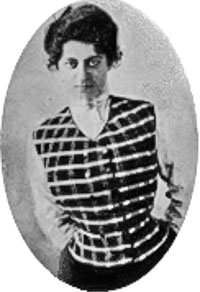
‘The latest smart notion for golf is a sort of combination of the sweater, with the gay gilt buttons of the regulation pink coat for golfing. This jacket is knitted of red yarn, having scarlet taffeta sleeves, and was originally intended to be worn as an extra wrap on cold days, under the golf coat, but its convenience for a summer wrap has brought it into high favor.’ (Los Angeles Herald, June 1900)
Red & White Striped Vests Are Fashionable
‘A dapper one is of a closely woven jersey; not striped, but more on the diamond shape. White stars here and there suggest a stripe. There is a collar on this one, but it is of a broad red and white plaid and the edge is bound in red silk. The material is very much like the regular golfing, double faced.
On the left side there is a tiny pocket just large enough for a watch or for car fare. It hardly looks like one, it is so small, but it answers the purpose just the same. […] another red one is awfully smart […] so many rows of red and then one of white. These stripes of wool are about two inches wide, and they are held together with a rope effect that gives the length that is needed. The white running one way and the red the other gives it besides the necessary length a swell tone. […]
Black & White Vests
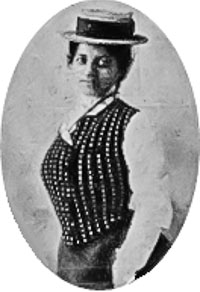
But don’t imagine for a moment that the only colors that are popular are red and white. There are a host of others that make quite as much noise and that look quite as neat. Next to the red ones come black and white. Some think they are the swellest ever, but the red comes in first at the finish.
The black and white, of course, come in plaids or stripes. The checks are the prettiest. The jersey does not attempt to be fancy, in fact that is not needed with the crossbars. Instead of stopping at the waist, they are cut longer and extend over the hips several inches.
As they are double-breasted, they can be drawn snugly together, and the curve at the waist is brought into prominence. By way of variety, the buttons follow up and down in a straight row, but they are not black nor even white. They are gold and not small gold ones either. No, they make quite a brave front.
Golf Vests In All Colors
Besides black and white, there are greens and reds, blues and yellow, entire blues, blacks, greens and whites. There is hardly a color that is not represented, and sometimes one wonders if the dyes hadn’t run away with themselves. The gayer they are, the better they seem to sell, and truly on the links or campus they are stunning. Few of the vests are made of the pure white. A touch of red, a dot of blue or a fleck of black, just a suspicion, you know, gives them a little tone that they seem to need.’ (San Francisco Call, November 1901)
Edwardian Sweaters For Sports
Women wore sweaters for walking and hiking, camping, hunting, rowing, tennis and golf, cycling, boxing, bowling, tobboganing, fishing and at the seashore. ‘The new sweaters that the shops are showing are just the things to wear rowing, golfing or playing tennis.’ (Los Angeles Herald, May 1903)
‘The sweater is such a practical garment that it should find a place in every wardrobe, and more especially in the athletic girl’s. It is well nigh invaluable for golfing, tennis, boating or automobiling. It is an extra garment, giving all the necessary warmth without the additional weight and restraint upon the easy motion of the body which the coat or jacket means. Altogether it is an extremely practical and serviceable addition to any wardrobe.’ (Stockton Independent, 1907)
Golf Sweaters
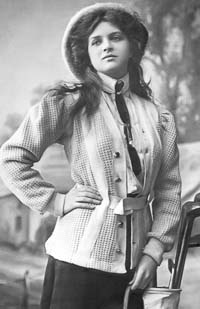
‘Sweaters and tams lend to the golfing girl the appearance of being perfectly equipped to dare and do, or at least to contend with any obstacle likely to obstruct the course of her ball over the links. These accessories are usually worn in matching shades of worsted, the cap set jauntily upon a coiffure guiltless of alien puffs and curls, and the reefer jacket, knitted in various stitches, and furnished with deep, capacious square pockets.
Tailors and haberdashers are trying to induce the enthusiastic golfer to adopt high collars as a protection for her neck, but she still clings persistently to the brilliantly hued handkerchief, and so becoming is it to her dusky complexion that there is slight chance of her sartorial mentors being able to affect a change. […] The silk jersey [corset cover] is also a useful accessory of the golfing costume proper, as in very warm weather it may be worn beneath the sweater, whose deeply pointed collarless neck need only be filled in with a soft silk scarf.’ (Los Angeles Herald, June 1908)
Beach Sweaters
‘It is quite the correct thing now to include a sweater in your seashore accessories. All the fashionable girls are wearing them after they come out of the water, and for those delightful little scampers up and down the beach they are simply ideal. The very smartest one is the boy’s sweater knitted of very heavy wool, the kind with a turtle neck that slips on over the head. One should have the sweater several sizes larger than one’s other garments, so it will go over the wet bathing suit easily.’ (Sotoyome Scimitar, July 1904)
Motoring Sweaters
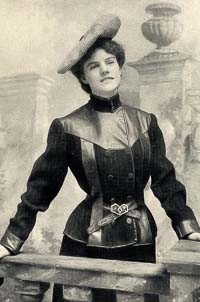
‘The sweater is gradually developing into a really natty and becoming garment, and one which should never be left behind when preparing for a motoring tour, especially in the United States, where changes of temperature are sudden. For the woman who dislikes capes the sweater is really a boon, as the worsted clings so closely to the figure that it adds slightly to the bulk.’ (Los Angeles Herald, May 1908)
Sweaters For Camping, Hunting & Fishing
‘At the close of the fashionable season Miss Anna Morgan packed her trunk with a rough, very short skirt or two, some heavy brown shoes, a felt hat, a sweater and other appurtenances for roughing it away from civilization, then packed one of her father’s special cars with necessaries for camping out, invited two or three girls and some other friends to join her and sped away on a hunting trip. She took a kitchen man or two along to cook and do the housework, but no maids to dress her or her companions.’ (Los Angeles Herald, December 1903) ‘The sweater that is ‘most liked for hunting or fishing is shaped to fit the form and gathered in at the waist that it may be tucked in under the skirt.’ (San Francisco Call, March 1909)
Tobogganing & Skating Sweaters
‘For skating or golfing the sweater is the ideal outer garment. It has all the warmth of a heavy coat and a flexibility which permits of perfect freedom to the arms and body.’ (Los Angeles Herald, January 1908)
‘Out of all the rides and walks and tobogganing I learned that no one need stay away from Yosemite in winter for lack of a “fitting outfit.” Wear ordinary everyday clothes. Take as extras a sweater, a pair of artics for snow walking, a scarf for a head wrap – for it is much more comfortable and convenient than a hat of any kind – and furs for comfort in stage or sleigh riding. If the snow be deep get barley sacks from the porter. They make the only 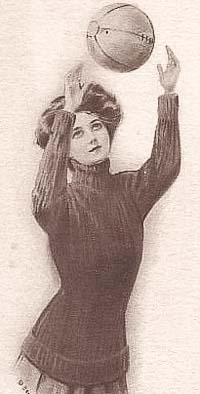 shoe covers and leggings that absolutely defy the snow, as it melts when disturbed.’ (San Francisco Call, February 1909)
shoe covers and leggings that absolutely defy the snow, as it melts when disturbed.’ (San Francisco Call, February 1909)
‘The jacket for a skating costume should be made full large, to allow of a sweater being worn underneath, as there will be few days so mild as to make this added protection unnessary.’ (Los Angeles Herald, January 1909)
Sweaters For Bowling & Gymnastics
‘Any dress that gives you perfect freedom will do for bowling. Either a shirt waist of a sweater is comfortable’ (Los Angeles Herald, May 1904). ‘The costume to be worn during these exercises [throwing a beanbag or medicine ball] is a simple one. No corset is used. A sweater or jersey, a pair of bloomers and rubber shoes are essential. The sweater will absorb the perspiration and is comfortable to work in.’ (San Francisco Call, October 1903)
How To Update Old Sweaters
‘It is always the neck and wrist edges that show the first signs of wear on a knitted sports coat or jersey, and often a garment is discarded as done for just because these parts are shabby or out-of-date.
Have you ever thought of knitting an entirely fresh set of collar and cuffs to replace the soiled parts, or to be added to a collarless jersey or coat? The existing collar and cuffs can quite easily be cut away and the raw edges neatly buttonholed with wool before sewing on the new set.
You will probably not be successful in getting wool the exact colour of your jersey, so it will be best to use a striking contrast, such as purple on a pale blue jersey, or emerald green on a white one; or if you already have two colours in the jersey, or it is of a specially brightly-hued tint, black makes a pleasing contrast. And this year particularly contrasts of colour are very much in vogue, so that your re-modelled jersey will be quite fashionable.’ (Needlework Economies, 1919)
How To Wash Edwardian Sweaters
‘In washing a sweater, rub thoroughly in warm water and soapsuds, rinse several times to get all the odor of the soap out of the wool. Be sure never to hang up a sweater to dry, as hanging ruins the shape and stretches the garment. If you can lay the sweater on the grass do so, having first spread out a heavy towel or a sheet folded.
If you must dry it on the fire escape or in a window, spread out first a newspaper and then cover that with towels or a sheet to keep the water from soaking through, and then lay the sweater on them, not stretched out, but rather in a heap. Half a day of hot sunshine will dry it, but it must be hot. Don’t try to wash a sweater on a cloudy day. In winter dry on the steam radiator.’ (Sacramento Union, February 1907)
25+ Free Edwardian Sweater Patterns
Click on the links under the pictures for the knit and crochet Edwardian sweater patterns.
Cable-Stitch Sweaters
From left to right:
-
Sweater In The New English Vest Stitch, 1908 (there’s a similar Edwardian white wool sweater jacket at the MET museum)
Basic Knit Sweaters
From left to right:
Ladies’ Knitted Sweater (The Delineator, 1895)
This sweater is similar to the popular 1895 white wool sweater at the MET museum and the 1890s red and white striped wool sweater at the DAR museum. And if you love the sweater but can’t or don’t want to knit it, you could buy knit fabric and sew the sweater instead what Liza @ Eras Of Enchantment did.
 ‘(Size, 34 inches, bust measure.) Cast on 135 stitches, and knit in rib knitting (knit 1, seam 1), until there are 36 rows of ribbing.
‘(Size, 34 inches, bust measure.) Cast on 135 stitches, and knit in rib knitting (knit 1, seam 1), until there are 36 rows of ribbing.
Thirty-seventh row.—K 1, p 1, until 5 stitches are worked, n, k and p as before to within 7 of the other end, n, knit the rest in plain ribbing. Continue in this way, narrowing in the same manner as in last row, until there are 27 more rows, and about 84 stitches on the needle. Make 16 rows without narrowing.
Next row—Knit and purl 6, widen by making 2 sts. in one, work to within 6 of the other end, widen, then knit and purl to the end of needle in regular order, being careful to keep the ribs regular. Next make * 4 rows without widening, then 1 row, widening as before; repeat 6 times more from *. Make 5 rows ordinary purl and knit.
Next row.—Work 5 sts., then n; work to within 6 of the other end, n, then p and k to the end. Make * 3 rows without narrowing, then 1 row narrowing as before; and repeat twice more from * . Now, without narrowing, work 20 ribs, or until half of the stitches are worked off the needle; this division is to begin the opening in the front. Work 44 rows back and forth on this half which brings you to the shoulder. Now cast off 15 sts., counting from the front edge of the opening, which leaves the front neck edge; then continue to work back and forth on the remaining stitches for about two rows. Next finish the other half of the front exactly like the first half, also casting off 15 sts. as before.
Cast on 30 sts. between the two sides of the fronts, to make the center of back, and knit all the stitches of both fronts, and those cast on between them, in rib style, to form the back, shaping it to correspond with the front. The opening in the front is underfaced at each side with a tape, and eyelet holes are worked through the outside and facing. A strip about 9 ribs wide made of Saxony is sewed to the left side for an underlap. Silk cord is laced through the eyelets to form the closing. In making the sweater a fancy border of any design desired may be made at the bottom. Owing to the fact that the sweater illustrated was not hand-made, directions for the fancy border are not given
For The Sleeves.—Use finer needles and 4-thread Saxony for the lower part, which is knitted thus: Cast on 53 stitches with the dark wool. Make 6 rows of ribbing; then with the white make 86 rows, then 6 rows of dark, then 6 more rows with the white, and continue using the white, knitting as follows: In the 7th row make 3 stitches, widen, then work to within 3 of the end and widen again; then work the rest as usual. Make * 9 rows, then widen in the next as in the 7th row, then repeat from * 6 times more; then make 7 more rows. Now join on the white Germantown, and use the coarser needles. Make 7 rows, then widen in the next, * 11 rows, widen in the next, and repeat 7 times more from last * . Make 6 rows, then narrow at each end in the same point where the widenings were made; then narrow in every 3rd row until there are eight more narrowings at each side, then make 5 or 6 more rows without narrowing. This finishes the sleeve.
Sew it up with an over-and-over stitch, or join with a single crochet stitch to within the 6 rows before the first narrowing. Also join the sweater under the arms, from where the first narrowing is made above the waist to the lower edges. Sew in the sleeved, adjusting the firlness thus: Make a box-plait at the shoulder where the seam would be, then 3 side-plaits turning from it at each side of the box-plait and a short distance apart (see picture). When worn, the close part of the sleeve extends from the wrist to the elbow and the full or upper portion falls in the fashionable style over the elbow. A tacking holds the fulness in place and may be made where most needed.
For the Sailor Collar.—Cast on 175 stitches with the white; make 5 rows plain rib (k 1, p 1), then join on the blue; work 5 stitches, then narrow, work to within 5 stitches of the end, then narrow again; then work the remaining stitches as usual. Work 3 rows without narrowing, then in the next narrow; then 2 rows without narrowing, but at the second row the white is joined, next row narrow, 2 rows plain, next row narrow, 1 row plain, next narrow, and repeat until there are 12 rows narrowed; then work 18 rows plain. There should be 49 rribs at its neck edge when the collar is completed. Sew it neatly to the neck with over-and-over stitches. If desired, the collar maybe brought up as high about the throat as desired by the use of a silk scarf knotted or bowed over it.
Sometimes sweaters are knitted whole in the front and back and left open on one shoulder. The opening is closed with buttons and button-holes, and a close collar, made deep enough to roll the same as the collar on a man’s sweater, is also buttoned together at the same side. In buying sweaters ready-made one has a choice in colors—white, navy-blue and garnet being obtainable; and those with plain close sleeves, or sleeves of the leg-o’-mutton shape, may also be chosen if the sleeve illustrated is not desired. An experienced knitter will require no instruction as to how to make either sleeve named, as the close sleeve only need be as large as the arm-hole of the sweater in hand while the leg-o’-mutton sleeve will need only a gradual widening from wrist to shoulder and may be as full as the knitter desires. In making a sweater, it will be a good plan to shrink the yarn, if white is used, before beginning the work.’
Striped & Tucked Sweaters
From left to right:
Elegant Sweaters With Silk Ribbons
From left to right:
Ladies’ Knitted Blouse Jacket (The Columbia Book Of Yarns, 1908)
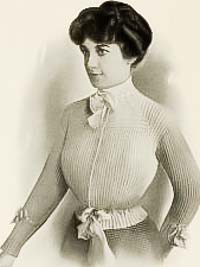 ‘The garment is knitted with the plaits running up and down, and is started at the edge of one front. With bone needles cast on 66 stitches.
‘The garment is knitted with the plaits running up and down, and is started at the edge of one front. With bone needles cast on 66 stitches.
First Row — Knit plain.
Second and Third Rows — Purl.
Fourth and Fifth Rows — Plain.
Sixth and Seventh Rows — Purl.
Eighth and Ninth Rows — Plain.
Tenth Row — Purl across, and at the end of needle knit 2 stitches together. Repeat, decreasing every third row at one end only, until 56 stitches are left. Continue knitting and purling, keeping both edges straight. Count 20 plaits from starting, cast on 20 stitches for shoulder, knit and purl 5 plaits, bind off 25 stitches, narrow 10 stitches, 1 stitch every other row (for armhole), then add 10 stitches (1 stitch every other row), add 25 stitches, knit and purl 5 plaits, bind off 20 stitches, knit and purl the edge straight for 23 plaits. (This is the entire back.)
Cast on 20 stitches, knit and purl 5 plaits, bind off 25 stitches, narrow 10 stitches (1 stitch every other row), then add 10 stitches (1 stitch every other row), add 25 stitches. Knit and purl 5 plaits, bind off 20 stitches. Knit other front to correspond with the first (this forms the body of the jacket), sew up shoulder carefully.
Yoke — With bone needles pick up all stitches around yoke. Knit and purl 8 plaits, knit or purl 2 stitches together in each row at the 4 corners. Make beading by casting yarn over needle 4 times, and knit 2 stitches together across the row. Next row, knit across and drop that cast over needle, so as to have same number of stitches before the beading; then on steel needles knit 2 and purl 2 for 18 rows.
Waistband — At bottom of jacket take up all stitches with bone needles, knit 1 row, and back, form beading like yoke, then on steel needles knit 2 and purl 2 for 24 rows.
Sleeves — Cast on bone needles 60 stitches. Make pattern like jacket, at the end of the 3d row increase 1 stitch. Repeat increasing every fourth row, until there are 72 stitches on the needle (the increasing to be done on 1 side only). Knit and purl 17 plaits, then decrease 1 stitch every 4th row on the same side with the increasing until 60 stitches remain. Bind off; pick up all the stitches on the straight edge, and knit 1 row plain. Form beading like yoke and waistband, then on steel needle knit 2 and purl 2 for 54 rows. Sew up sleeve and sew sleeve in jacket.
Finish with 6 yards of ribbon 3 inches wide, drawn through the beading at neck, waist and sleeves.’
Single-Breasted Sweater Jackets
From left to right:
Double-Breasted Sweater Jackets
From left to right:
Late Edwardian Easy Knit Sweater (Housekeeper’s Handy Book, 1913)
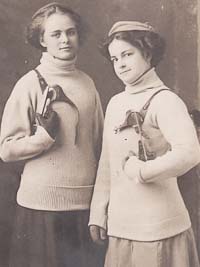 ‘One who knows how to knit may easily knit a sweater using measurements, and varying number of stitches according to size desired.
‘One who knows how to knit may easily knit a sweater using measurements, and varying number of stitches according to size desired.
Measure the length of back, width between shoulders, length of front from top of shoulder to under arm, neck and wrist. Cast on as many stitches as seems advisable; seventy stitches will make one for thirty-six inch bust measure.
Knit one or two inches plain garter stitch for a border, using steel needles, then with bone needles begin any pattern chosen. Knit till the desired length from bottom of sweater to under arm, bind off at each end of the needle (for under arm), five for a small sweater, and eight for a larger one.
Every other row, narrow at each end of the needle till five more for a small sweater, and eight for a larger, have been taken off at each end of the needle, the number of stitches being reduced ten or sixteen according to size. Continue without narrowing till back is required length from neck to bottom of sweater.
Divide the stitches for the neck and shoulders. Knit the first twenty-five for a small sweater and thirty for a large one; slip these on to a cord. Bind off a certain number for neck in centre of back, being careful not to have too large a number or the neck will be loose. The number of stitches left on the needle to knit should be equal to those taken off on the cord so that the two front sides will be alike.
Knit plain for one inch, then widen every third row at the neck side till there are more stitches on the needle – twenty more stitches for a small sweater and twenty-four for a large one. Knit three inches more, increasing at the beginning of each row till eight for a small sweater, and twelve for a larger sweater, have been added.
Knit without widening till the work measures four inches for a small sweater and seven inches for a larger one, from shoulder to under arm. On the side away from the neck cast on seven stitches for a small sweater, twelve for a larger sweater; this extends under the arm and makes the width of the front. Knit till front is long as back without border, then knit garter stitch the same width as the back. Sew up under the arms.
The border is not necessary; one can begin the pattern at once when starting sweater. Take stitches from the cord on to the needle, and knit the second front like the first.
SLEEVES
Two directions are given, the sleeves always beginning at the top. No 1. Cast on sixty stitches, increase two at the beginning of each row till there are one hundred. Knit this number for one inch; then narrow at each end of the needle every fourth row till there are sixty remaining. Knit and do not narrow again till the inside seam is the required length.
Change to steel needles and knit garter stitch to match the border; or, if no border is used, knit one, purl one, for three inches, which will make a close cuff.
No 2. Cast on forty-six stitches, start pattern at once. At each end of the needle cast on three stitches every row till there are eighty-eight stitches on the needle. Knit pattern and do not increase for three inches; then narrow one stitch at each end of the needle every fifth row till there are forty-six stitches. Knit till the sleeve is the required length.
The cuff is made by using the steel needles and either knitting garter stitch or seaming.
BORDER
A border is made by casting on the steel needles twelve stitches, and knitting garter stitch. For a band up the front, it should be sewed on from the edge of the right-hand front round the neck and down the other side. It may be of the same color as the sweater or of a contrasting color.
Button-holes may be made at regular intervals in this border by binding off four stitches in the middle of the needle and on the next row, casting the four stitches on again.
Pockets and collars are knitted separate and sewed on the sweater, the pockets always the same color as the sweater.
Cast on as many stitches for the collar as the neck requires, always allowing an inch more than the neck really measures. Knit garter stitch or seam till the width desired.’
Crochet Golf Vests & Sweater
From left to right:
Crochet Sweater (The Columbia Book Of The Use Of Yarns, 1904)
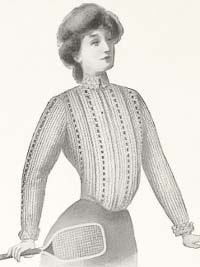 ‘Make a chain of 127 stitches, work 126 Sg. C in this chain, work hack and forth, taking the stitch from the back, for 4 rows, or 2 ribs. Continue working back and forth, taking the stitch double, for 6 rows.
‘Make a chain of 127 stitches, work 126 Sg. C in this chain, work hack and forth, taking the stitch from the back, for 4 rows, or 2 ribs. Continue working back and forth, taking the stitch double, for 6 rows.
Make 1 row of D C (drawn loose). Work 4 rows of Sg. C, taking the stitch double, work 4 rows, taking the stitch from the hack. Break off yarn.
Begin at the other end of row, work 63 Sg. C, taking the stitch double, work back and forth on these 63 stitches for 11 rows, always taking the stitch double, this forms the back, make 63 chain stitches at the end of row. (This brings 126 stitches in the row.) Work back on these 126 stitches with Sg. C, taking stitch from the back. Work back and forth taking the stitch double for 4 rows. Make 1 row of D. C. (drawn loose). Work 7 rows of Sg. C, taking the stitch double. Work 2 rows of Sg. C, taking the stitch from the back.
On the next row, work 38 Sg. C, taking the stitch double. Work back and forth on these 38 stitches for 8 rows, always taking the stitch double. Crochet the 8 rows of 38 stitches with slip stitch to the back. See that only one rib is on the right side by armhole.
On the right front work 56 Sg. C, taking the stitch double. Work back and forth for 5 rows, always taking the stitch double. Make 1 row of D C (drawn loose).
Work 5 rows of Sg. C, taking the stitch double, and increasing 2 stitches at the waist end of every row. Now work 4 rows of Sg. C, without increasing. Break off yarn. This finishes the right front. Work the left or other front to correspond.
Work 2 rows of D C around the waist end of garment to form a waist band.
SLEEVE— Make a chain of 81 stitches; on this chain work 80 Sg. C. taking the stitch double. Work back and forth for 21 rows. Make 1 row of D C. Work 18 rows of Sg. C, taking stitch double. Break off yarn.
On the next row work 44 Sg. C, taking the stitch double. Break off yarn. Repeat this for 4 more rows, working 5 stitches less in each row, and being careful to break off yarn at end of each row. Work 1 row of 20 Sg. C stitches. Break off yarn. Work 2 rows back and forth on these 20 stitches, always taking the stitch double; seam or join sleeve together.
Work 5 rows of crazy stitch around the cuff, turn back, and sew down lightly. Sew sleeves into armhole. Close the fronts with hooks and eyes. Draw ribbon through each row of D C.
COLLAR— Work 2 rows of D C around the neck, make 5 rows of crazy stitch and sew down lightly.’
Please Pin It!

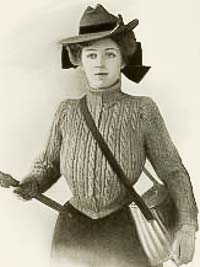

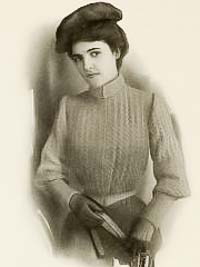

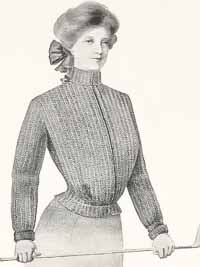
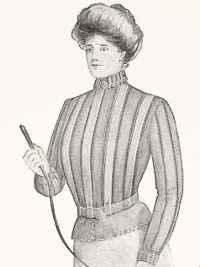

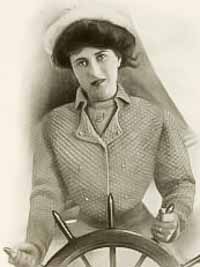
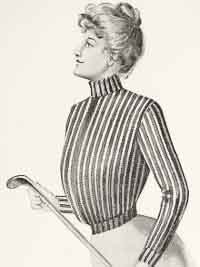
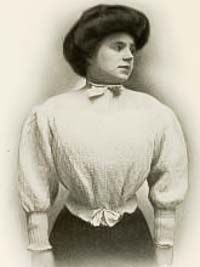
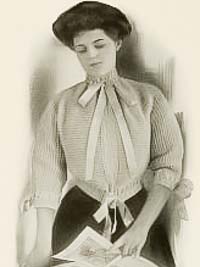

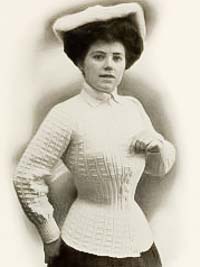
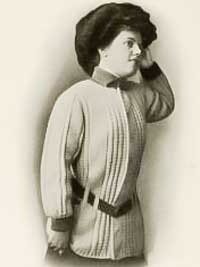
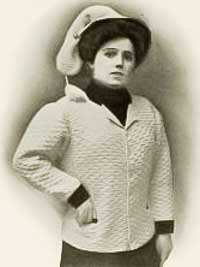
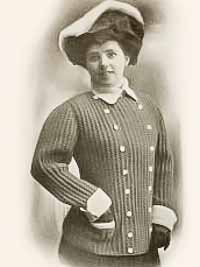
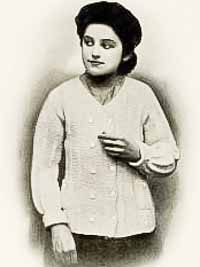
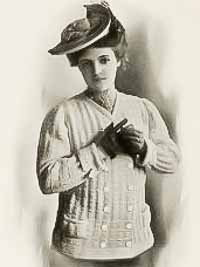

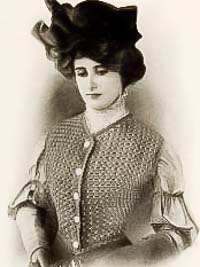
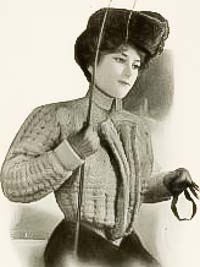
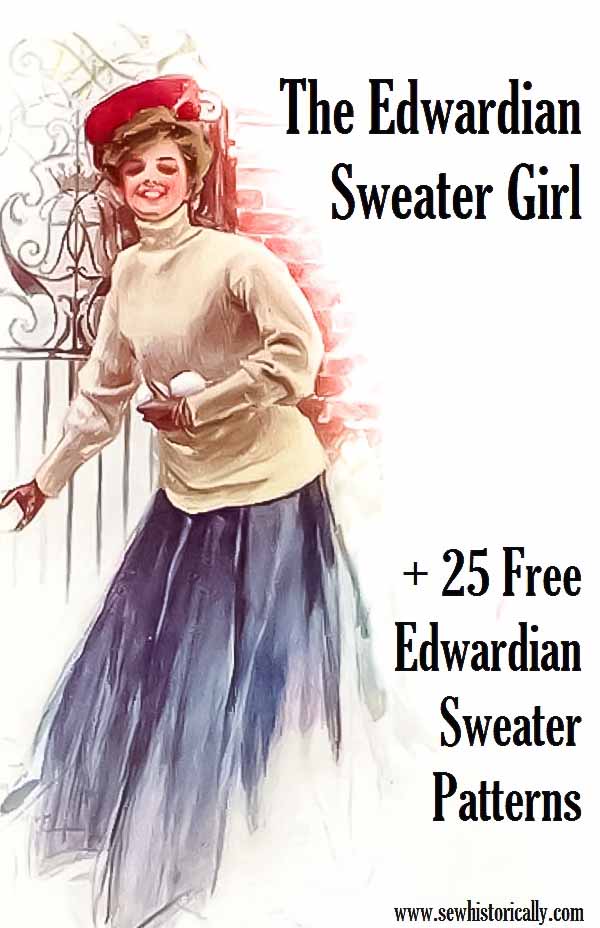
As always your posts are such an interesting read.
Thanks so much, Rebecca! 🙂
Thank you for sharing these. If I get started this January, I could have one or two done by summer to wear at an event. Thank you so much for sharing.
Thanks, Lee! 🙂 I’m glad you liked it!
What a wonderful post! I especially liked the video! -Marci @ Stone Cottage Adventures
Thanks, Marci!
I love this stuff. Thanks for posting.
Thanks for stopping by!